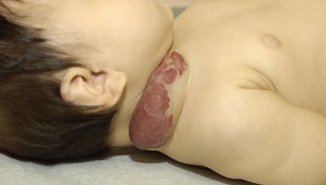Hemangiomas of Infancy
Also known as: strawberry birthmarks, red birthmark
What are hemangiomas of infancy?
Hemangiomas of infancy are the most common vascular tumors in infants. These benign lesions usually have an initial phase of rapid growth from the first 6 to 8 months of life and after this they start to involute by themselves.
One third of the hemangiomas in infants will resolve by 3 years of age, one third by 6 years of age, and the last third by 9 years of age. By the end of their involution, these tumors can leave a faint mark or scar in the area were they were localized or a residual amount of superficial blood vessels. Depending on the body area they can have a medical significance for treatment or no treatment.
Most hemangiomas in infants grow in areas that do not interfere with other organs or cause disfigurement and just require observation by a doctor; but a small amount of them can grow in areas that interfere with:
- Vision (eyelids)
- Breathing or eating (throat)
- Ulcerate in mucosal areas (lips, diaper area, neck)
- Cause disfigurement by interfering with regular formation of cartilage (nose and ears)
- Compromise the heart work due to its large size or multiple lesions
What are the common hemangiomas of infancy?
Read more detailed information about different kinds of hemangiomas found in children.
Image of Hemangiomas of Infancy

What are the treatment options for hemangiomas of infancy?
The majority of them don’t require medical treatment; but if required, they will include:
- Oral medications such as propanolol or prednisone
- Pulsed dye laser
- Nd:YAG laser
- Co2 laser or surgical excision depending on the clinical evaluation
This page was last updated on: August 27, 2021 01:19 PM
Inspiring Patient Stories

Patient of the Month: Alanis
After a healthy delivery of her newborn baby girl Alanis, Ana was told that she was born with a small caramel colored birthmark on her arm. Not immediately alarmed by the news, Ana waited for their first appointment with the pediatrician who then referred them to Ana Margarita Duarte, MD, Director of the Division of Dermatology at Nicklaus Children’s Hospital.
Read More.
Learn more about
Infantile/Ulcerated Cavernous Hemangiomas
The term hemangioma refers to a common collection of blood vessels on or under the skin that usually develops in babies.
Cherry Angiomas
A cherry angioma is a small to large, fairly common, benign, bright cherry red or purple, smooth or raised area, of clusters of tiny blood vessels on the skin.
Gorham Syndrome
Gorham syndrome is a rare condition involving gradual bone loss that can affect one or more bones.
PELVIS Syndrome
PELVIS syndrome is used for the association of lumbosacral or genital area hemangiomas
Pulsed Dye Laser
Pulsed dye laser is a laser where the laser beam passes through a dye in order to target blood vessels and treat capillary malformation and other vascular lesions.